Kite Surfboards: Design, Performance, and Selection Guide
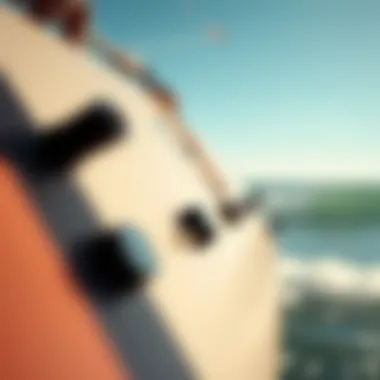
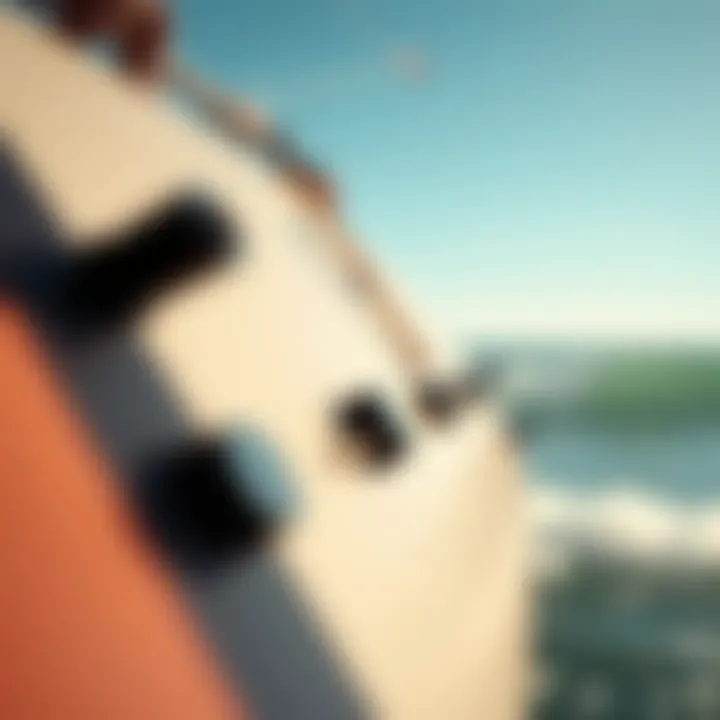
Intro
In the vast realm of water sports, kiteboarding stands out as a thrilling blend of surfing, sailing, and acrobatics. Among its core components, the kite surfboard plays a pivotal role in determining the overall experience for riders. Understanding the nuances of these boards can significantly enhance one’s skills and enjoyment on the water.
This guide aims to illuminate the intricate world of kite surfboards, looking at their designs, functionality, and the profound impact they have on the sport. From the various types of surfboards available to the materials and technologies that set them apart, this article offers insights that cater to both budding enthusiasts and veteran kiteboarders.
Whether you are new to the scene or an instructor looking to refine your craft, the exploration of kite surfboards will prepare you for the waves ahead. The importance of selecting the right board, maintaining it properly, and understanding the techniques that come into play can't be overstated. As you navigate through this guide, you will find practical advice and in-depth analysis aimed at boosting your confidence and performance on the water.
So, let’s dive into the essentials of equipment which shapes your kiteboarding journey.
Equipment Insights
Latest Gear Reviews
When it comes to kite surfboards, each type brings its own flavor to the sport. Boards can vary greatly based on style, size, and material. A well-informed choice can find you gliding smoothly through choppy waters or soaring high with effortless jumps.
For instance, the North Kiteboarding Carve is often praised for its responsive handling, making it ideal for both freestyle and wave riding. It features a slightly wider outline that provides stability, enhancing the rider's confidence. On the other hand, the Slingshot Misfit with its twin-tip design is versatile, allowing for easy transitions from toe-side to heel-side.
Here are a few things to consider when selecting your board:
- Riding Style: Are you into freestyle tricks or riding waves? Pick a board suited to your passion.
- Size Matters: Typically, larger boards provide more buoyancy and are easier to ride, while smaller ones are great for advanced maneuvering.
- Material Quality: Epoxy boards are lightweight and offer good performance, while traditional fiberglass boards are durable but heavier.
Essential Gear Maintenance
To keep your kite surfboard in peak condition, regular maintenance is key. Here are some tips that can help you prolong the life of your gear:
- Rinse with Fresh Water: After a session, wash your board to remove salt and sand that can cause wear over time.
- Inspect for Damage: Regularly examine your board for dings and scratches. Repair them promptly to avoid further damage.
- Store Properly: Keep your board out of direct sunlight to prevent delamination and make sure it’s stored on a flat surface to avoid warping.
"A well-maintained board can be the difference between a smooth ride and a struggle against the elements."
By taking care of your equipment, you not only enhance your own experience but also contribute positively to the broader kiteboarding community. This commitment inspires others and upholds the standards we have as riders.
As your understanding of the equipment deepens, so does your mastery of technique. Next, we will explore the multitude of techniques that can elevate your kiteboarding performance.
Intro to Kite Surfboards
Kite surfboards are an essential piece of equipment for enthusiasts looking to catch the wind and ride the waves. They bridge the gap between traditional surfing and the exciting world of kiteboarding. Understanding what kite surfboards are and how they evolved is crucial for both new riders and seasoned veterans as they embark on their aquatic adventures.
In this section, we will discuss how defining kite surfboarding sets the stage for comprehending its unique characteristics. Moreover, a look at the historical evolution of surfboards provides context, shedding light on how past innovations have shaped modern designs. This backdrop is not merely about nostalgia; it reflects ongoing advances that impact performance and safety today.
Defining Kite Surfboarding
Kite surfboarding is an exhilarating water sport that involves riding a board while being pulled by a large kite. It's a blend of surfing, windsurfing, and paragliding. The beauty of kite surfboarding lies in its ability to harness wind power for both propulsion and maneuverability.
Kite surfboards differ from traditional surfboards primarily in design and functionality. They tend to be constructed for greater buoyancy, enabling riders to glide over water at impressive speeds. The board's shape, size, and even the materials used are tailored to optimize performance under the influence of wind and waves.
Riders can choose from various styles of boards, including twin-tip, directional, and foil boards, each offering unique experiences. Understanding these distinctions is key to selecting the right board, which directly influences your effectiveness on the water. It’s essential for riders to grasp the nuances of their gear to maximize enjoyment and safety while kiteboarding.
Historical Evolution of Surfboards
Surfboards have undergone significant transformations since their inception. Initially made from wood, these boards were used by ancient Polynesians, reflecting a deep cultural heritage. As the sport gained traction worldwide in the 20th century, materials and manufacturing processes evolved.
The introduction of foam and fiberglass in the 1960s revolutionized the surfing scene. These materials allowed for lighter, stronger, and more maneuverable boards. During the late 20th century, as kiteboarding began to emerge as a distinct sport, specific adaptations of surfboard design began to appear. Innovations like shorter lengths and wider widths became popular, addressing the unique demands presented by kite power.
As this sport continues to evolve, advancements in technology and materials remain relevant. The introduction of carbon fiber and other composite materials has further influenced surfboard design, allowing for lighter, more durable boards. Riders who appreciate these developments benefit from improved performance, making the connection between historical evolution and modern application evident.
"The evolution of kite surfboards isn’t just about the ride; it’s about enhancing the entire experience on the water."
Types of Kite Surfboards
Kite surfboards are the unsung heroes of kiteboarding, influencing every aspect of the ride. This section delves into the different types of kite surfboards, shedding light on their unique characteristics, benefits, and considerations that kiteboarders should keep in mind. Understanding the various board types can significantly enhance one’s performance on the water, allowing for a more tailored approach to riding according to personal styles and conditions.
Directional Surfboards
Directional surfboards are designed for a single direction, resembling a traditional surfboard. This type of board excels in wave riding, as it offers more control and responsiveness when carving through ocean swells. Made for those who appreciate the essence of surfing, directional boards often come with a pointed nose and a wider tail, promoting stability during high-speed maneuvers.
Benefits of Directional Surfboards:
- Excellent for riding waves and enhancing your surfing experience.
- Heightened responsiveness, allowing for sharper turns and better carving.
- Generally provide a smoother ride in choppy conditions due to their design.
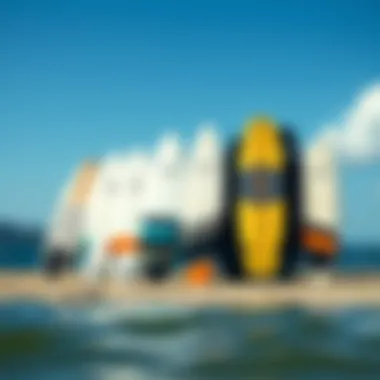
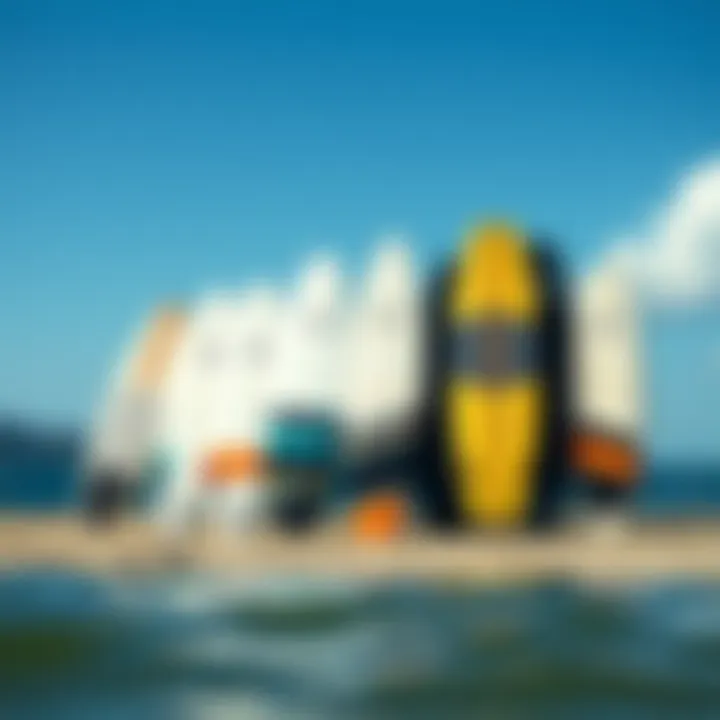
However, these boards require riders to maneuver with a specific riding style, generally facing forward, which may not be as forgiving for beginners. That said, those willing to invest the time can find a wealth of pleasure coasting over the ocean’s face.
Twin-Tip Boards
Twin-tip boards stand out for their versatility and the ability to ride in both directions. Symmetrical in shape, these boards allow for easy transitions, making them popular among many kiteboarders, from beginners to experts. For those looking to learn tricks or simply enjoy freestyle riding, twin-tips offer an incredible platform to experiment and grow.
Advantages of Twin-Tip Boards:
- Easy to ride for beginners, making the learning curve less daunting.
- Built for tricks, jumps, and all kinds of freestyle maneuvers.
- Many twin-tips are designed to perform well in multiple conditions, suitable for both flatwater and choppy waves.
While they lack the specialized performance that directional boards have in wave conditions, the convenience and adaptability of twin-tips often make them a go-to choice for those just getting their feet wet in kiteboarding.
Foil Boards
Foil boards represent an innovative leap forward in kiteboarding technology. Equipped with a hydrofoil beneath the board, these unique designs allow them to glide smoothly above the water’s surface at lower speeds. This feature not only minimizes drag but also opens up new realms of possibilities for kiteboarding, particularly in lighter wind conditions.
Key Features of Foil Boards:
- Provides the ability to ride in light winds that would typically ground other boards.
- A mesmerizing experience, as riders hover above the water resulting in a smooth and quiet ride.
- Offers unique angles and perspectives, allowing kiteboarders to explore uncharted waters and conditions.
Nevertheless, foil boards do come with a learning curve, requiring riders to develop a sense of balance and timing. For many, the thrill of mastering a foil board is well worth the effort, offering a unique kiteboarding experience unlike any other.
For more information on kiteboarding and gear, visit Wikipedia or engage with the kiteboarding community on Reddit.
Key Materials in Kite Surfboard Construction
The construction of kite surfboards hinges on a few core materials. Selecting the right materials can greatly enhance the overall functionality and durability of the board, contributing to an improved riding experience. It’s like finding a well-fitted glove for your hand; the better the fit, the more seamless the experience.
Fiberglass Composition
Fiberglass is a staple in the kite surfboard industry. Its reputation comes from its strength-to-weight ratio, allowing for lightweight designs without sacrificing durability. When a kiteboard is crafted using fiberglass, it often has a layer of resin infused into the fine glass strands. This combination ensures that boards can withstand not just the pressure of waves but also the shocks from jumps and landings.
Upon impact, fiberglass flexes, absorbing a significant amount of energy before returning to its original shape. This property helps to create boards that feel lively underfoot—great for carving through turns or skipping across flat water. Moreover, fiberglass can be easily molded into various shapes, providing manufacturers the flexibility to innovate designs that cater to different riding styles.
Benefits:
- Lightweight yet strong
- Excellent for shock absorption
- Versatile in shaping and design
EVA Foam Impact Protection
EVA foam, or Ethylene Vinyl Acetate, might not be the centerpiece of kiteboard construction, but it plays an often-unheralded but critical role in protecting riders. Most kiteboards feature an EVA foam layer on the deck. If you’ve ever felt a soft, cushioned surface underfoot, that’s likely the EVA foam at work.
This impact protection serves a couple of purposes. Primarily, it provides grip, allowing riders to maintain their footing in challenging conditions. It also cushions the feet during hard landings, reducing fatigue especially during long sessions. After all, having tender feet can easily ruin a day on the water.
The foam’s resilience means that it can absorb shock without losing its shape. Boards with EVA foam tend to feel more forgiving, giving riders the confidence to push their limits without the fear of discomfort.
Benefits:
- Provides excellent grip
- Cushions impacts during landings
- Enhances comfort over long sessions
Carbon Fiber Advantages
Carbon fiber is the material of choice for advanced and competitive kiteboards. Although it has a higher price point, the advantages can far outweigh the costs. Known for its incredible strength while being lightweight, carbon fiber brings a whole new level of performance to kite surfing.
The primary benefit of using carbon fiber is how it translates to speed and responsiveness on the water. Boards made from this material accelerate quickly and turn almost on a dime. This carving maneuverability is crucial, especially when making tight turns in competitive settings. On top of that, carbon fiber’s rigidity means that boards provide excellent feedback, allowing riders to feel every nuance of the water beneath them.
Another notable feature of carbon fiber is its longevity; it’s less likely to suffer from wear and tear than traditional materials, making it a worthwhile investment for serious kite surfers. In a sport where conditions can change on a dime, having dependable equipment can be a game-changer.
Benefits:
- High strength-to-weight ratio
- Exceptional speed and responsiveness
- Durable and long-lasting
Using the right materials in kite surfboard construction not only enhances the board's performance but also contributes to a safer and more enjoyable experience on the water.
In summary, the materials chosen for kite surfboards—fiberglass, EVA foam, and carbon fiber—each play unique and vital roles. Their interplay determines how a board behaves in various conditions, which ultimately shapes the rider's experience. Selecting a kite surfboard involves understanding these materials to match personal riding styles and needs effectively.
Understanding Board Shapes and Sizes
When it comes to kite surfboards, understanding board shapes and sizes isn't just a technical detail; it's a crucial aspect that can significantly affect your riding experience. The shape and size of a board can change how it performs in the water, how it interacts with the wind, and how maneuverable it is, making this topic essential for anyone keen on enhancing their performance.
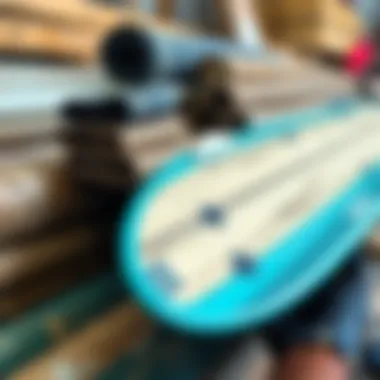
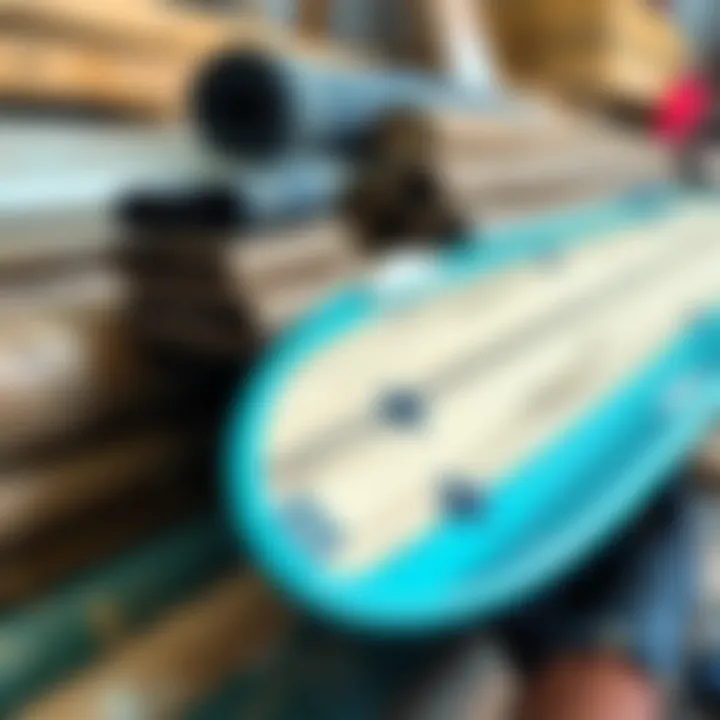
Every kiteboarder, whether a newbie or seasoned rider, should grasp the basics of board dimensions. There's more than meets the eye when it comes to selecting the right board.
- Why It Matters: The board's shape influences both speed and stability. A wider board typically offers better floatation and stability, especially for beginners, while narrow boards excel in performance and speed, catering to more advanced riders seeking agility.
- Size Matters: Length affects how the board cuts through the waves, while width determines how buoyant it is. Selecting the right combination that aligns with your skill level and riding style allows for an optimal experience on the water.
"A board that's right for you could make the difference between a thrilling ride and a frustrating fall."
Length and Width Specifications
Length and width are the backbone of board design, playing pivotal roles in performance and comfort.
- Length: Typically measured in centimeters, longer boards offer ease in planning and are better suited for choppy waters. They provide a smoother ride but lose some maneuverability. For instance, a board around 140-150 cm could suit beginners while a 120-135 cm size might cater to advanced riders looking for agility.
- Width: Wider boards, generally between 40-45 cm, tend to provide greater stability and floatation, making them suited for beginners or heavier riders. On the flip side, narrower boards can enhance performance and speed but require better balancing skills.
Finding the right mix of length and width based on conditions and personal preference is vital. It could be likened to finding the right shoe size; it must be comfortable yet functional for the best performance.
Rocker Profiles: How They Affect Performance
Rocker profiles refer to the curvature of a board from tip to tail and play an essential role in performance.
- Flat Rocker Boards: These have minimal curve and are great for speed. They perform well in flat water and are ideal for those who seek a fast ride. However, they are less forgiving in choppy waters.
- Continuous Rocker: This type of board presents a smooth transition from tip to tail. It offers a balanced ride, providing good speed without compromising on the ability to handle waves. It's akin to a middle ground, suitable for various conditions and riding styles.
- Hybrid Rocker: Combining elements of both flat and continuous rocker, it allows for versatility in performance. Riders can experience a faster glide with enough adaptability to manage turns and jumps effectively.
Each rocker style can sculpt your riding experience, making it critical to understand their nuances.
Tail Shapes: Their Influence on Riding Style
The shape of the tail not only contributes to the overall aesthetic of the board but fundamentally impacts how a rider can perform tricks and maneuvers.
- Square Tail: This shape provides more surface area, enhancing grip and stability. It is ideal for freeride styles and excels in upwind performance. Riders looking for a balanced ride, where stability and control are valued over speed, might consider this option.
- Rounded Tail: Offering a more fluid ride, this shape enhances turning capabilities and is preferred by those who like to perform tricks. Perfect for freestyle riders, it allows for quick direction changes and spins.
- Swallow Tail: With a distinct cut-out design, this tail shape increases overall speed and helps manage choppy waters effectively. It's particularly embraced by riders who crave performance in variable conditions.
Choosing the right tail shape can dictate not just your riding style but also your overall enjoyment while kitesurfing. It pays to be mindful in your selections.
Performance Metrics for Kite Surfboards
Understanding performance metrics is crucial for anyone involved in kiteboarding. These metrics not only speak to how well a kite surfboard performs in various conditions but also guide riders in selecting the most suitable board for their personal riding style. Key performance metrics include speed, stability, and maneuverability, each impacting your overall riding experience. The ability to analyze these aspects can make the difference between a thrilling ride and a frustrating one, particularly in competitive contexts.
Speed and Acceleration
Speed dictates much of what you can achieve on a kite surfboard. The faster the board can go, the more exhilarating the experience. Acceleration refers to how quickly a board can reach its top speed, which is vital for competitive riders who need to make split-second decisions.
- Factors Influencing Speed: Several elements come into play when considering speed and acceleration, such as board shape, weight, and materials. A board with a streamlined design often cuts through the water more efficiently, while lightweight materials aid in achieving quicker bursts of speed.
- Importance of Speed in Performance: For seasoned kiteboarders, speed allows for greater tricks and maneuvers, pushing the limits of what can be accomplished on the water. However, a balance must be struck; the rider must be capable of handling the powers of speed, especially under challenging conditions.
Stability in Various Conditions
Stability plays a significant role in ensuring riders feel secure on their boards, especially when facing different environmental conditions like waves or strong winds.
- Weight Distribution: A board's stability often comes down to how weight is distributed. A well-balanced surfboard can absorb shocks from waves, enabling smoother rides.
- Board Shape Effects: The shape of the board also has an impact here. Wider boards tend to offer more stability, making them a wise choice for less experienced riders who prioritize control over speed.
- Weather Variability: As kiteboarding enthusiasts know, conditions can change rapidly. A stable kite surfboard allows for easier adjustments. This adaptability is crucial when dealing with the unpredictability of wind gusts or sudden changes in water currents.
Turning Radius and Maneuverability
Turning radius and maneuverability determine how easily a board can change direction. These metrics are particularly important for kiteboarders looking to hone their skills, making them indispensable for tricks and sharp turns.
- Design Characteristics: Boards that feature a tighter turning radius are generally more responsive. Such designs allow riders to make quick adjustments, making it easier to navigate through challenging waters or perform technical tricks.
- ** Rider Skill Level**: A board with excellent maneuverability is often favored by intermediate and advanced riders who lean towards more dynamic riding styles. Understanding your own comfort level with these features can help ensure that your rides are not just thrilling but safe as well.
"Performance metrics provide a roadmap. By understanding them well, you're not just buying a board; you're investing in your kiteboarding journey."
In summary, the performance metrics of speed, stability, and maneuverability form the backbone of a kite surfboard's functionality. Recognizing how these elements interact allows riders, from novices to pros, to choose the most compatible gear for their unique preferences and conditions. For further insights on performance and gear selection, check out resources such as Wikipedia, and community discussions on Reddit.
Focusing on these metrics helps kiteboarders elevate their performance while enjoying this exhilarating sport.*
Choosing the Right Kite Surfboard
Choosing the right kite surfboard is pivotal for maximizing both performance and enjoyment on the water. A well-suited surfboard not only enhances your riding experience but also plays a crucial role in skill development. With a plethora of options available, making an informed choice becomes essential, especially for those new to the sport. This section will explore the critical aspects of selecting a surfboard that aligns with your personal needs and riding style.
Assessing Your Skill Level
Before diving into the specifics of board types, it's important to honestly evaluate your skill level. Are you just starting out, or have you been tearing up the waves for years? Knowing where you stand can help narrow down your options significantly.
- Beginner: If you’re at the beginning of this thrilling journey, a wider board with more volume can be beneficial. This type of board offers more stability and buoyancy, which makes it easier to get up on the water and ride. Some good examples are twin-tip boards that provide versatility in directional riding.
- Intermediate: As you build confidence and start experimenting with jumps and tricks, you might consider directional boards that enhance your maneuverability. At this stage, you may want a balance of stability and performance to help refine your technique.
- Advanced: If you find yourself landing tricks and pushing boundaries, specialized surfboards tailored for performance can be your best bet. Look for boards with specific characteristics such as lightweight construction and a responsive rocker to better suit aggressive riding.
Matching Board Characteristics with Riding Style
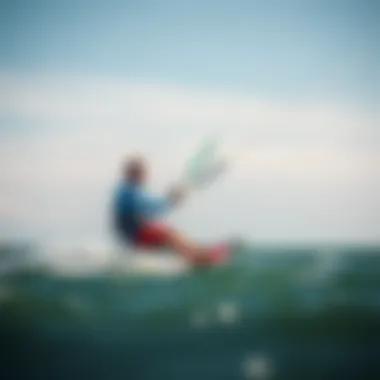
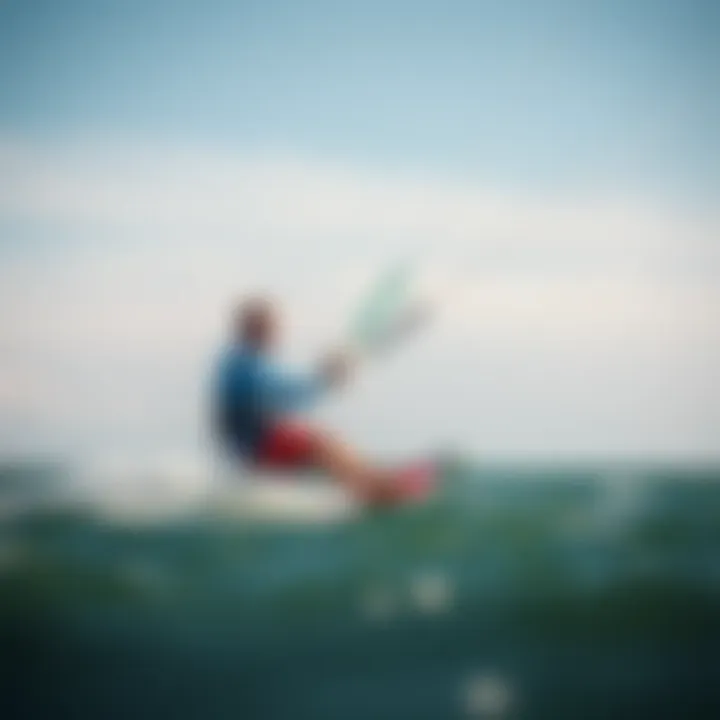
Riding style is also a vital piece of the puzzle when selecting a kite surfboard. It’s not just about getting on the water; it’s about how you want to express yourself when you’re out there. Think about how you ride, the conditions you prefer, and what you aim to achieve.
- Freestyle: If you enjoy pulling off tricks and want a board that caters to aerial skills, consider a twin-tip with a stiffer flex. This type enhances pop and control during jumps. The more radical your moves, the more responsive your board should be.
- Wave Riding: For those drawn to harnessing the ocean's power, a directional board with a pronounced rocker allows for smooth turns and carving in the waves. Look for boards that are designed to handle the conditions specific to wave riders.
- Freeride: If you’re a free spirit who rides for pleasure rather than competition, versatility becomes key. Consider boards that can handle diverse conditions while still providing the satisfaction of carving across the water or gliding through light winds.
In summary, the process of selecting the right kite surfboard goes beyond mere aesthetics; it's about understanding yourself as a rider. Evaluating your skill level and pinpointing your preferred riding style are fundamental to finding a board that not only meets but exceeds your expectations. As every kiteboarder knows, the fusion of equipment and rider prowess is what ultimately defines the kiteboarding experience.
"A kite surfboard is not just a piece of equipment; it’s an extension of the rider."
For those interested in diving deeper into board trends and innovations, check out discussions on forums like Reddit for real-world advice and experiences shared by fellow kiteboarders.
Maintenance and Care for Kite Surfboards
Maintaining a kite surfboard is not just about cleaning it up and putting it away after a day at the beach. Keeping your board in top shape can significantly impact your performance on the water, prolong its life, and ultimately save you money in the long haul. Each trip to the ocean puts your equipment through the wringer, so understanding how to care for your surfboard becomes fundamental for any kiteboarding enthusiast.
Routine Inspections and Damage Prevention
Before heading out onto the water, it's critical to conduct a quick assessment of your kite surfboard. Look for any cracks, scratches, or other signs of damage that could compromise its integrity. Missing screws or delaminating layers can lead to more serious problems down the line. It takes just a few minutes but can prevent a ride from turning into a frustrating experience.
Key inspection points include:
- Deck and Bottom Surface: Look for scratches or dents that could impact glide.
- Leash and Fins: Ensure they’re securely attached and not showing signs of wear.
- Straps and Pads: Check for tears or loosening to help keep your feet firmly in place.
For those who might be prone to overlooking minor issues, set a routine. Inspect your board after every session, and don’t skimp on checking any wear and tear. If you are unsure about what to look for, a quick search online or even visiting kiteboarding forums like reddit.com can help you spot potential problems.
Storage Recommendations
How you store your kite surfboard can be as crucial as how you maintain it on the water. Leaving your board in direct sunlight or damp conditions can lead to deterioration of the materials over time. The goal here is simple: create an environment that protects it from harsh elements.
Here are a few tips for optimal storage:
- Use a Board Bag: Always keep your board in a padded bag when not in use. This will protect it from scratches and impacts.
- Store Indoors: Find a cool, dry place to store your board away from direct sun and moisture. A temperature-controlled room is ideal, especially during extreme weather conditions.
- Vertical or Horizontal Orientation: Storing your board standing upright can prevent warping and helps save space.
"Proper care and maintenance can extend the lifespan of your kite surfboard, ultimately saving you money and ensuring peak performance every time you hit the waves."
By taking the time and effort to care for your board, you'll not only enhance your riding experience but also cultivate a deep appreciation for the equipment that supports your passion for kiteboarding. Remember, a well-maintained board is a happy board, ready for countless thrilling rides.
The Role of Kite Surfboards in Competitive Kiteboarding
Competitive kiteboarding is an electrifying arena where every detail counts. Among those details, kite surfboards play a pivotal role. These boards not only serve as a platform for the rider but also significantly influence performance metrics that can make or break a competition.
Choosing the right kite surfboard for competition isn’t just a matter of preference; it’s about enhancing potential and honing skills in a high-pressure environment. Riders often find themselves weighing construction materials, shapes, sizes, and other specifications to gain that competitive edge. The nuances here are paramount, and understanding them can elevate a competitor from just another participant to a formidable contender.
Influence on Performance in Competitions
The connection between a kite surfboard's design and its contribution to performance cannot be overstated. Each characteristic of a board can affect speed, maneuverability, and stability—all crucial factors in competitive scenarios.
- Speed and Acceleration: A lighter board made from advanced materials like carbon fiber allows for faster acceleration. It’s a bit like choosing sports shoes; lighter ones typically make you quicker on the field. Boards designed with a sharp outline can slice through water with minimal resistance, granting competitors that much-needed blade-like agility on the waves.
- Stability Under Pressure: Competitions often involve unpredictable weather and challenging water conditions. A well-designed kite surfboard provides the stability needed to remain balanced even in rough environments. This means having the right rocker profile—too much or too little can dramatically alter how a board performs in chop or swell.
- Maneuverability: The turning radius of a board can determine how quickly a rider can execute complicated tricks or navigate through tight spaces. Boards with a more pronounced tail can pivot easily, allowing riders to make rapid directional changes that are essential in head-to-head racing or freestyle routines.
"Choosing the right kite surfboard is like finding the right pair of ice skates; it has to match your style and skill perfectly to achieve that winning glide."
Emerging Trends in Competitive Gear
As kiteboarding evolves, so does the technology behind kite surfboards. Emerging trends are reshaping the playing field, allowing for equipment that anticipates needs before they arise.
- Hybrid Designs: Many brands are now experimenting with hybrid boards that merge characteristics of both twin-tips and directional surfboards. These boards can adapt to various riding styles and conditions, providing flexibility for riders who are versatile in their skills.
- Eco-Friendly Materials: Sustainability is becoming a significant focus across all sports. The use of bio-resins and recycled materials in kite surfboard construction is on the rise. Competitors today are embracing gear that not only performs well but also has a reduced environmental footprint.
- Smart Technology Integration: Innovations like integrated sensors that track performance metrics in real-time are making their way into kite surfboards. This technology offers data that can be utilized to refine techniques, making athletes perform more effectively at competitions.
Epilogue
The topic of kite surfboards wraps up a profound journey through the intricacies of this fascinating sport. Understanding the elements discussed, from the types of boards and the materials used in their construction to the performance metrics and maintenance tips, is not just for seasoned kiteboarders, but also for budding enthusiasts. This article highlights how selecting the right equipment can immensely impact one's experience on the water.
Summarizing Key Insights
In the grand scheme of kite surfing, the choice of board and its characteristics plays a pivotal role in performance. A few key takeaways include:
- Diversity in Selection: Not all boards are created equal. Knowing the difference between a directional surfboard, a twin-tip, and a foil board is crucial. Each type complements different riding styles and wave conditions.
- Material Matters: The construction materials - fiberglass, foam, and carbon fiber - not only affect durability but also performance. Choosing the right combination can optimize speed and maneuverability.
- Performance Parameters: How a board's shape, size, and other specifications affect stability, speed, and turning radius is vital for any rider looking to excel.
- Maintenance is Key: Regular checks and proper storage can extend the life of your board and ensure you’re always ready to ride when the moment strikes.
Grasping these insights prepares riders to make informed decisions, enhancing both safety and enjoyment while kiteboarding.
Future Directions in Kite Surfboard Technology
The landscape of kite surfboard technology is ever-evolving. As materials science advances, we can expect lighter and stronger boards equipped with enhanced performance features. Future trends might include:
- Smart Technology Integration: Imagine surfboards integrated with sensors that monitor performance and suggest adjustments based on conditions and rider skill.
- Sustainable Materials: The push for eco-friendly products could lead to the development of surfboards made from recycled or renewable materials without compromising performance.
- Customizable Designs: Advances in 3D printing may allow for greater personalization of kiteboards, enabling riders to tailor their gear to specific preferences in style and functionality.
The journey of kiteboarding starts with the right board, and understanding its dynamics can set the stage for countless thrilling rides.
For more information and updates in the kiteboarding community, websites like kitesurfing.org and reddit.com/r/kitesurf are excellent resources.







